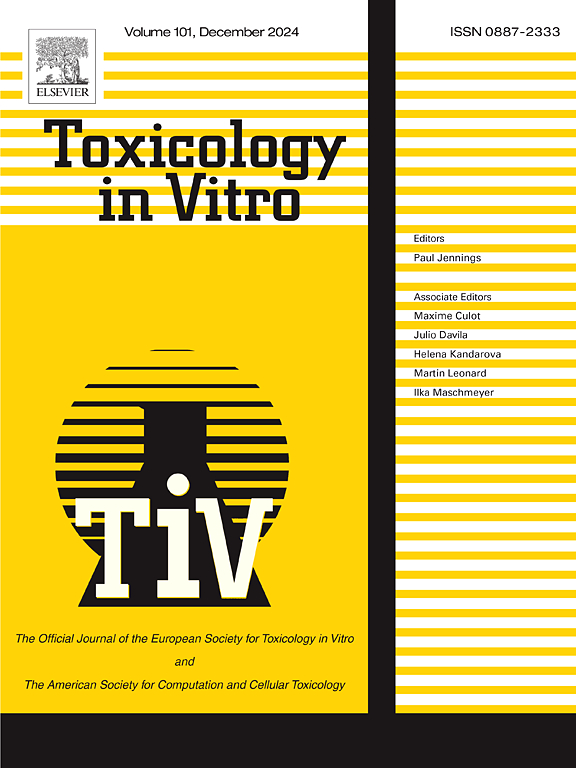NDMA enhances claudin-1 and -6 expression viaCYP2E1/ROS in AGS cells
IF 2.6
3区 医学
Q3 TOXICOLOGY
引用次数: 0
Abstract
Carcinogenic N-nitroso compounds, especially N-nitroso dimethylamine, increase the risk of gastric cancer development. Cytochrome P450-2E1 metabolizes this compound, thus generating an oxidant microenvironment. We aimed to evaluate in gastric adenocarcinoma cells if its effect on CYP2E1 and ROS affects signaling pathways associated with gastric cancer oncogenesis. The impact of N- nitroso dimethylamine upon CYP2E1 and ROS activation/secretion was evaluated by the DCFDA assay protocol, TER measurements, Stat3, pSTAT3, ERK1/2, and pERK1/2 expression, claudins-1 and -6 expression, and finally mRNA values of IL-1β IL-6, IL-8 and TNFα. Our results showed that exposure to N- N-nitroso dimethylamine disrupts the regulation of Stat3 and Erk1/2, alters the expression of claudin-1 and claudin-6 tight junction proteins, and increases the secretion of pro-inflammatory cytokines. These alterations induce a continuous local inflammatory process, an event identified as a gastric cancer promoter. In summary, N-nitroso dimethylamine can disrupt cell mechanisms associated with gastric cancer oncogenesis.
NDMA 通过 CYP2E1/ROS 增强 AGS 细胞中 claudin-1 和 -6 的表达。
致癌的 N-亚硝基化合物,尤其是 N-亚硝基二甲胺,会增加胃癌的发病风险。细胞色素 P450-2E1 会代谢这种化合物,从而产生氧化微环境。我们的目的是在胃腺癌细胞中评估其对 CYP2E1 和 ROS 的影响是否会影响与胃癌致癌相关的信号通路。我们通过 DCFDA 检测方案、TER 测量、Stat3、pSTAT3、ERK1/2 和 pERK1/2 表达、claudins-1 和 -6 表达以及 IL-1β IL-6、IL-8 和 TNFα 的 mRNA 值评估了 N-亚硝基二甲胺对 CYP2E1 和 ROS 活化/分泌的影响。我们的研究结果表明,暴露于 N-亚硝基二甲胺会破坏 Stat3 和 Erk1/2 的调控,改变 claudin-1 和 claudin-6 紧密连接蛋白的表达,并增加促炎细胞因子的分泌。这些改变会诱发持续的局部炎症过程,这一过程已被确定为胃癌的促发因素。总之,N-亚硝基二甲胺可破坏与胃癌致癌相关的细胞机制。
本文章由计算机程序翻译,如有差异,请以英文原文为准。
求助全文
约1分钟内获得全文
求助全文
来源期刊

Toxicology in Vitro
医学-毒理学
CiteScore
6.50
自引率
3.10%
发文量
181
审稿时长
65 days
期刊介绍:
Toxicology in Vitro publishes original research papers and reviews on the application and use of in vitro systems for assessing or predicting the toxic effects of chemicals and elucidating their mechanisms of action. These in vitro techniques include utilizing cell or tissue cultures, isolated cells, tissue slices, subcellular fractions, transgenic cell cultures, and cells from transgenic organisms, as well as in silico modelling. The Journal will focus on investigations that involve the development and validation of new in vitro methods, e.g. for prediction of toxic effects based on traditional and in silico modelling; on the use of methods in high-throughput toxicology and pharmacology; elucidation of mechanisms of toxic action; the application of genomics, transcriptomics and proteomics in toxicology, as well as on comparative studies that characterise the relationship between in vitro and in vivo findings. The Journal strongly encourages the submission of manuscripts that focus on the development of in vitro methods, their practical applications and regulatory use (e.g. in the areas of food components cosmetics, pharmaceuticals, pesticides, and industrial chemicals). Toxicology in Vitro discourages papers that record reporting on toxicological effects from materials, such as plant extracts or herbal medicines, that have not been chemically characterized.
 求助内容:
求助内容: 应助结果提醒方式:
应助结果提醒方式:


